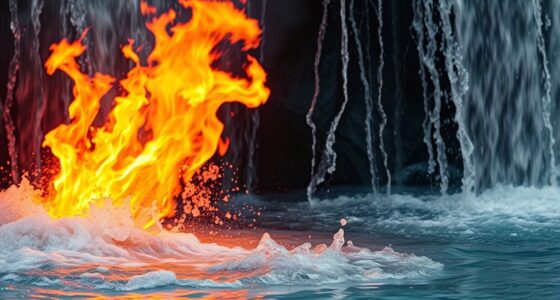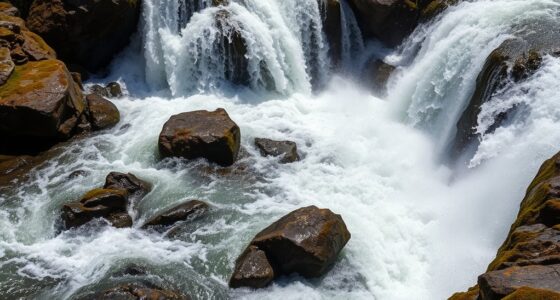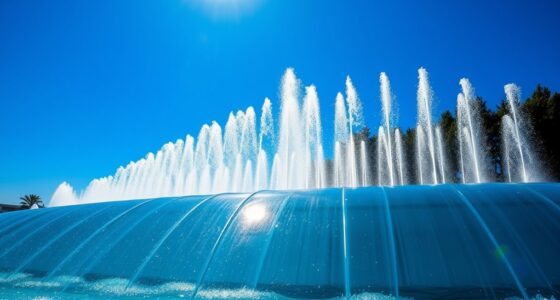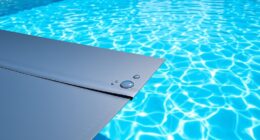When choosing between sheer descents and scuppers, consider the soundscape you want. Sheer descents produce a smooth, steady cascade that masks background noise and creates a calm, soothing atmosphere. Scuppers, on the other hand, generate lively, layered sounds with splashes and gurgles, adding energy to your space. Your choice depends on whether you prefer tranquil consistency or dynamic variety—exploring these options further can help you craft your ideal sound environment.
Key Takeaways
- Sheer descents produce a consistent, gentle cascade with a soothing, uniform sound ideal for tranquil environments.
- Scuppers generate varied, layered sounds with splashes and gurgles, creating a lively, dynamic auditory experience.
- Taller sheer descents create louder, resonant sounds, while scuppers’ noise levels depend on flow rate and environmental factors.
- Sheer descents are easier to maintain and more durable, suitable for minimal upkeep settings.
- Choose sheer descents for serenity and uniformity; opt for scuppers to add acoustic interest and lively ambiance.
Understanding the Basic Designs of Sheer Descents and Scuppers
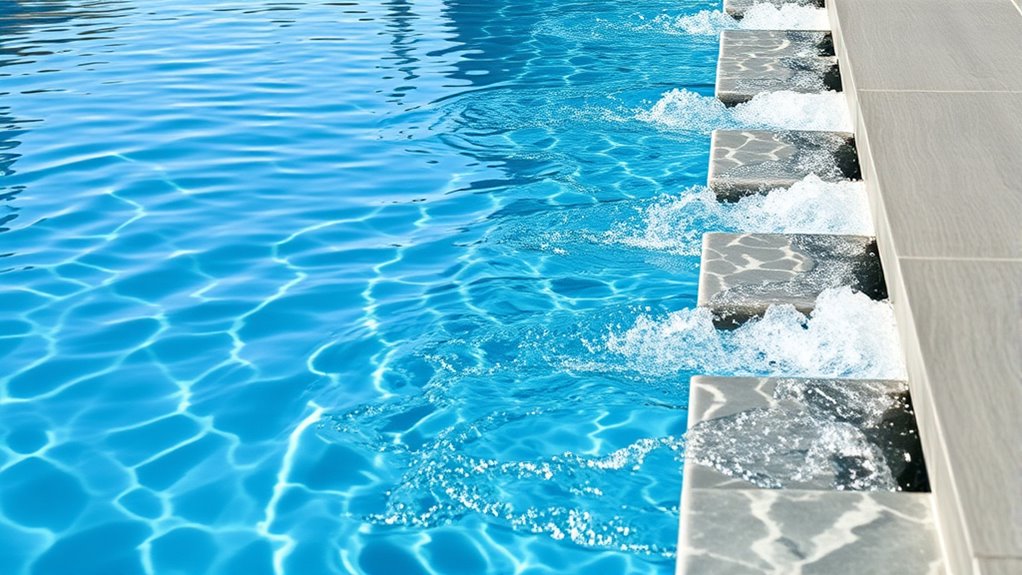
To understand the basic designs of sheer descents and scuppers, it’s important to recognize how each feature directs water away from a structure. Sheer descents are narrow, vertical openings built into walls or facades, guiding water down smoothly and continuously. They are typically made from metal or stone and create a clean, sleek look. Scuppers, on the other hand, are larger openings or pipes set into a parapet or ledge, allowing water to flow through and drain away quickly. They often have a more functional appearance and can be integrated into various architectural styles. Both features serve the essential purpose of channeling water, but their designs influence not only water flow efficiency but also the aesthetic and sound qualities of your water feature. Understanding how each zodiac sign personality traits can influence your choice might help you select a feature that matches your design preferences and personal style.
The Acoustic Qualities of Sheer Descents
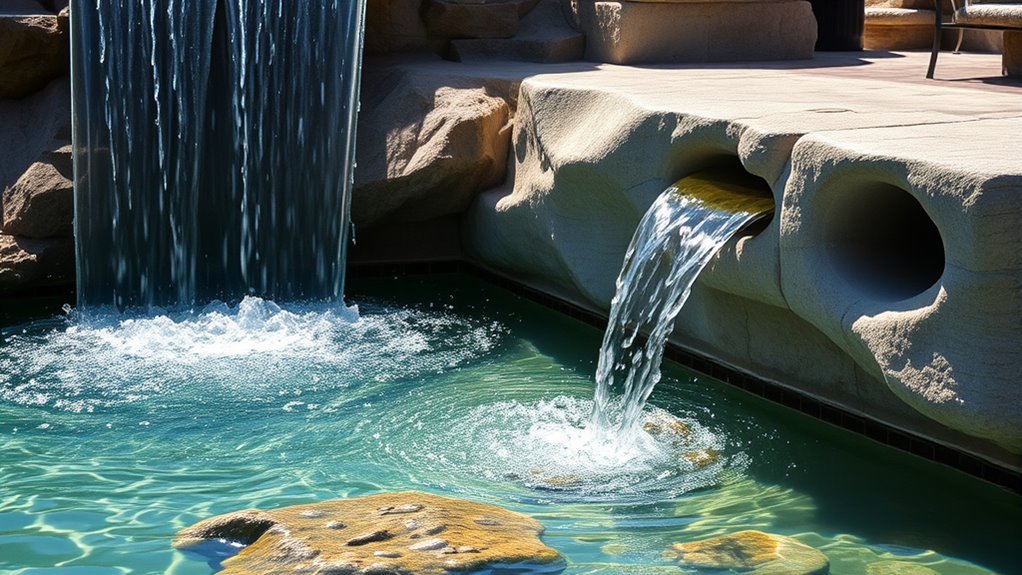
Sheer descents produce a soothing, consistent sound that enhances the ambiance of any water feature. As water flows smoothly over the edge, it creates a gentle, uniform cascade that’s easy on the ears. This steady sound helps mask background noise, making your outdoor space more peaceful. Unlike other water features that produce irregular or louder noises, sheer descents deliver a calm, continuous hum. The sound’s volume depends on the water flow rate and the height of the drop, allowing you to customize the acoustic experience. The clarity of the water’s fall contributes to a pure, crisp auditory effect. Additionally, the water flow regulation ensures the sound remains steady and pleasant. Overall, the sound of a sheer descent adds serenity and elegance, making it ideal for creating a tranquil environment.
The Sound Profile of Scuppers
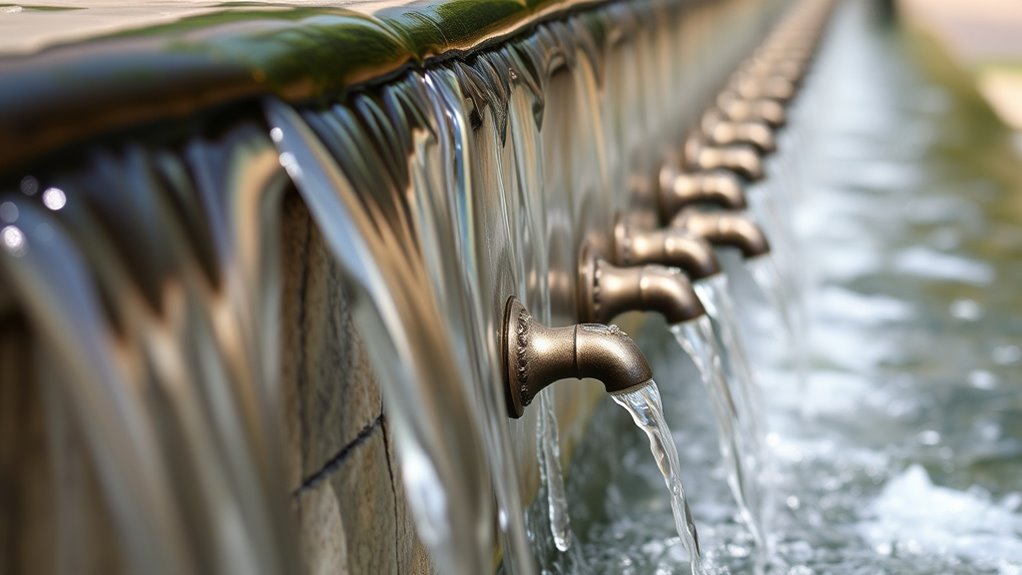
Unlike the steady, uniform sound of a sheer descent, scuppers produce a more dynamic and varied auditory experience. As water flows through a scupper, you’ll notice a range of sounds—gurgles, splashes, and soft drips—that change with water volume and wind conditions. The noise is layered and unpredictable, creating a lively atmosphere. You might hear sharp splashes when water hits the basin or gentle trickles when flow slows. This complex sound profile adds character and energy to your outdoor space. The irregularity keeps the auditory experience engaging, making scuppers a favorite if you want a vibrant, ever-changing water sound that captures natural movement and spontaneity. Additionally, just as AI models require ongoing monitoring and safety measures, the sounds of scuppers can be carefully designed to ensure they create a pleasant and safe environment.
How Water Flow Affects Sound Production
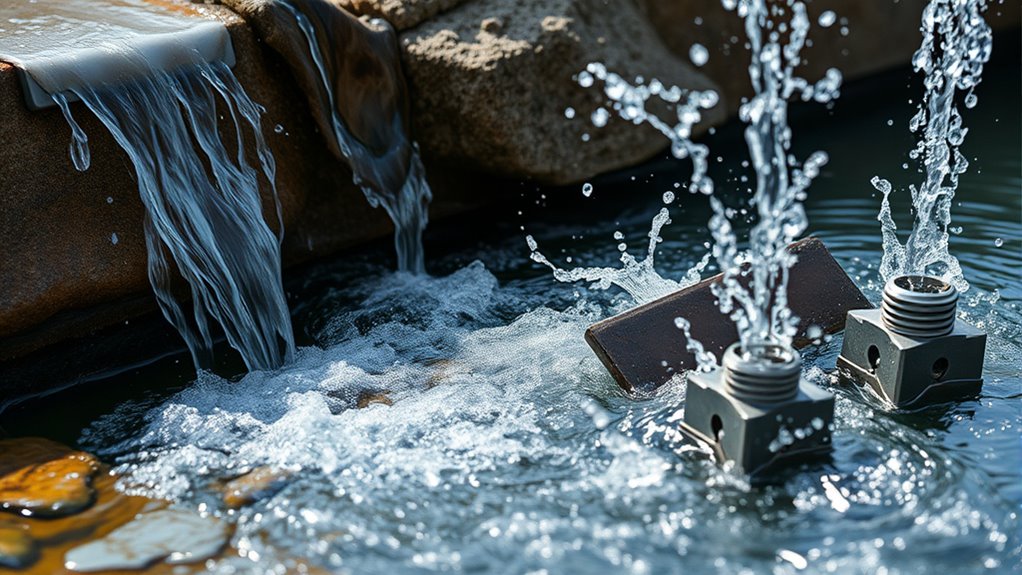
The way water flows over a feature directly influences the sound it produces. Higher flow rates and larger volumes tend to create louder, more powerful noises, while lower flow results in softer sounds. Additionally, the height from which water drops affects the intensity and tone of the sound, shaping the overall experience.
Flow Rate and Volume
Water flow rate and volume directly influence the sound produced by water features, shaping the ambiance they create. Higher flow rates generate louder, more energetic sounds, while lower volumes produce softer, calming noises. Adjusting volume allows you to customize the soundscape to suit your space. Consider the table below to understand how different flow rates affect sound:
| Flow Rate (GPM) | Sound Intensity |
|---|---|
| Low | Gentle, trickling sound |
| Moderate | Soft splashing, bubbling |
| High | Roaring, powerful water flow |
| Volume | Effect on Atmosphere |
| Small | Intimate, subtle ambiance |
| Large | Bold, dominating presence |
Adding the right lighting can further enhance the tranquil or lively effect of your water feature, complementing the sound profile and overall ambiance.
Drop Height Impact
Drop height plays a crucial role in determining how water sounds in your feature, as taller drops generate more impact and energy. When water falls from a greater height, it creates a louder, more resonant sound that can dominate a space. The increased drop height produces a sharper splash and more vigorous movement, amplifying the auditory experience. Conversely, shorter drops tend to produce softer, subtler sounds, ideal for creating a calming atmosphere. The height also influences the quality of the sound; taller drops often generate deeper, more resonant tones, while shorter drops produce higher-pitched, delicate sounds. Additionally, the performance and reliability of a water feature can be affected by factors such as pump quality and installation, which are essential to consider for consistent sound production. Understanding this relationship helps you choose the right feature to match your desired sound profile, whether you crave a dramatic cascade or a gentle trickle.
Environmental Factors Influencing Water Sound
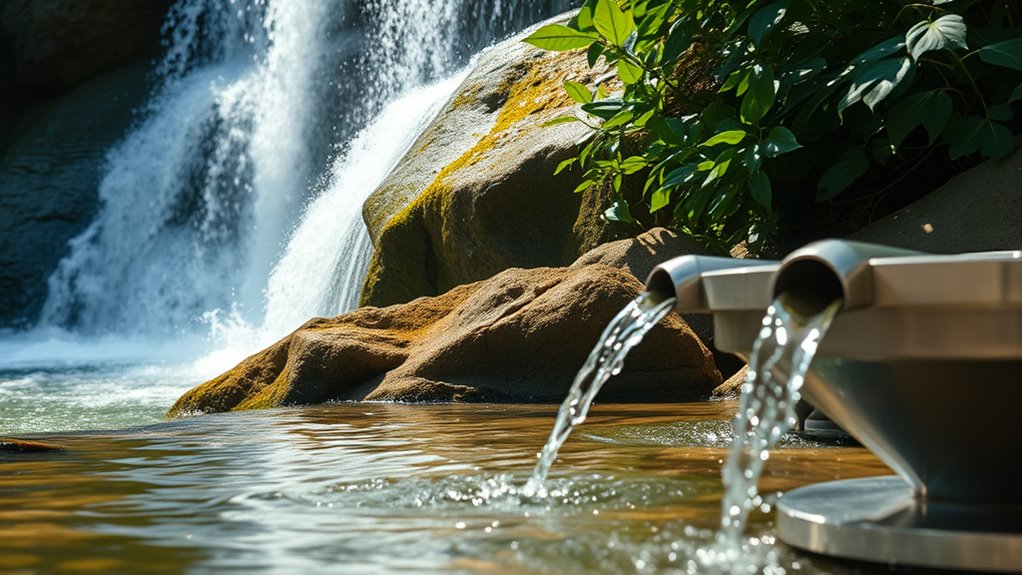
Environmental factors such as wind, temperature, and ambient noise considerably influence how water sounds are experienced. Wind can create ripples and turbulence, amplifying or distorting the water’s natural sound. When it’s cold or hot, the water’s movement may slow down or become more turbulent, changing the tone and volume of the noise. Ambient noise from nearby traffic, conversations, or nature can mask or enhance the water sound, affecting your perception of its calming or lively qualities. Additionally, humidity levels can influence how sound travels, either dampening or carrying it further. Glycolic acid can also play a role in maintaining skin health, which may indirectly impact how you experience environmental changes affecting your water feature. Understanding these factors helps you anticipate how your water feature will sound in different conditions, ensuring you select a design that maintains its desired auditory effect regardless of environmental changes.
Creating Ambiance: Choosing Based on Desired Noise Levels
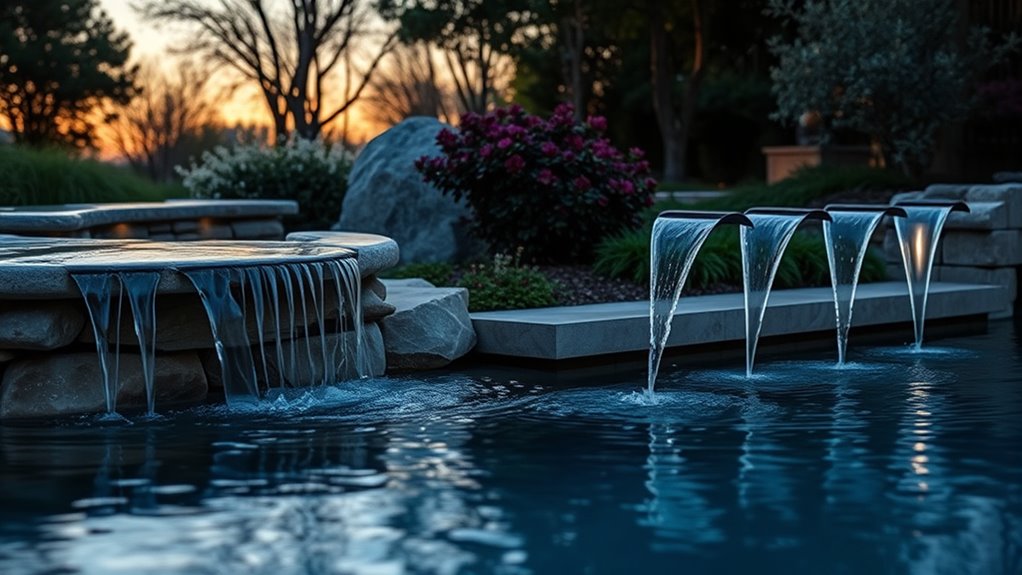
Choosing the right water feature depends largely on the ambiance you want to create, especially regarding noise levels. If you prefer a calming, subtle sound, a scupper can provide gentle water flow that gently whispers rather than roars. It’s ideal for creating a relaxing atmosphere without overwhelming the space. Conversely, if you want a lively, energetic vibe, a sheer descent produces a louder, more dynamic sound that can serve as a focal point. Consider where your water feature will be located and how much noise is appropriate for that setting. Think about whether you want the water to be a background element or a prominent feature. Matching the sound level to your desired ambiance helps guarantee your water feature enhances your outdoor environment perfectly. Additionally, understanding sound levels associated with different water features can help you make a more informed choice.
Comparing Maintenance and Durability Through Sound Considerations
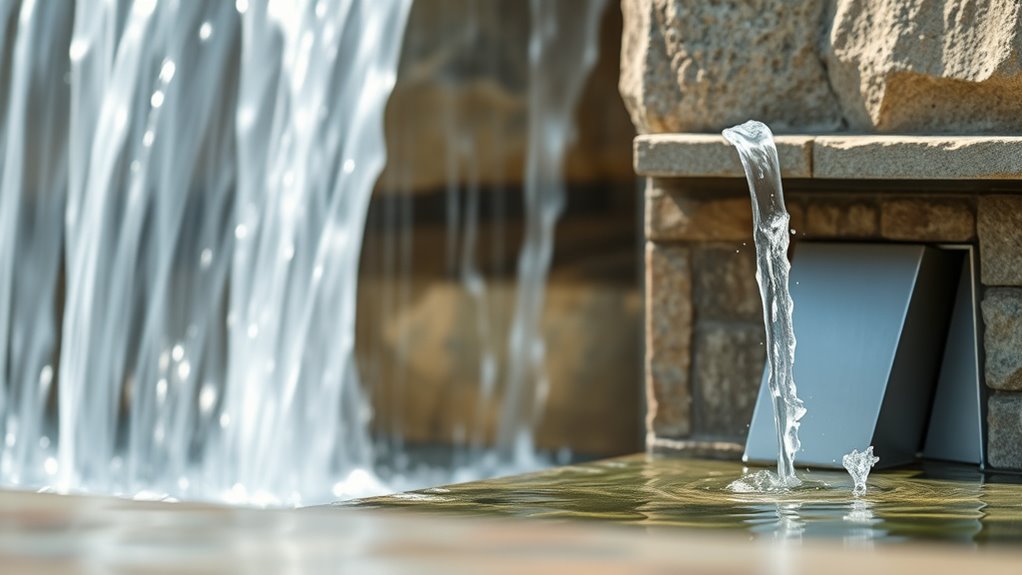
When comparing water features like sheer descents and scuppers, considering maintenance and durability is essential, especially since sound plays a role in their longevity. Sheer descents often have smooth surfaces that resist buildup, making cleaning easier and reducing maintenance time. Their durability benefits from fewer moving parts and protected structures, meaning they’re less prone to damage over time. Conversely, scuppers may require more frequent cleaning due to splash zones and debris accumulation, increasing maintenance efforts. The sound produced also indicates potential wear; a consistent, clear flow suggests good condition, while irregular sounds may hint at blockages or damage. Additionally, the choice of materials can influence the overall maintenance requirements and lifespan of these features. Overall, sheer descents tend to be more durable and easier to maintain, making them a practical choice if sound quality and longevity are priorities.
Aesthetic Appeal and Its Impact on Acoustic Experience
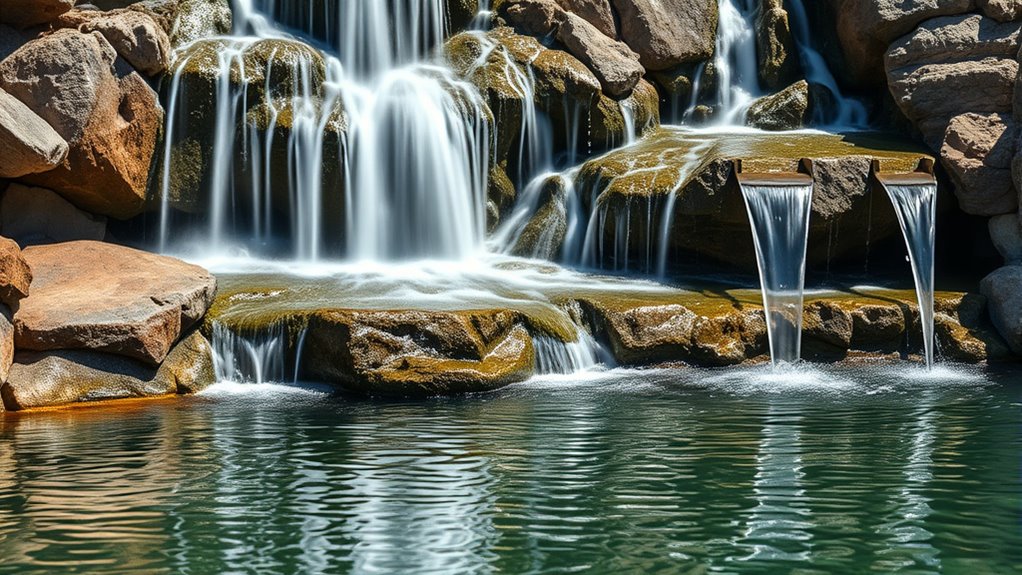
Your water feature’s visual harmony can boost the soothing soundscape you experience daily. Material choices and design details also shape how the water’s noise blends with your surroundings. Paying attention to these aesthetic elements helps create an inviting atmosphere that enhances both beauty and acoustics. Incorporating diverse planter designs can further elevate the overall ambiance with creative and unique elements.
Visual Harmony Enhances Sound
Visual harmony between water features and their surroundings substantially influences the acoustic experience. When your water feature complements its environment, it creates a seamless visual flow that enhances the overall ambiance. This harmony allows your eyes and ears to work together, making the sound feel more natural and immersive. For example, a water feature with a design that echoes nearby natural elements, like rocks or plantings, blends effortlessly, amplifying its soothing qualities. Conversely, a disjointed or overly contrasting feature can disrupt this balance, making the sound seem out of place. When your water feature aligns visually with its setting, it promotes a sense of tranquility, allowing the sound to resonate more deeply and genuinely, enriching your sensory experience. Ethical hacking principles remind us that understanding the environment thoroughly can help in creating more secure and harmonious systems or settings.
Material Choices Influence Acoustics
The materials you choose for your water feature directly affect both its aesthetic appeal and the way sound is produced and perceived. Different surfaces reflect, absorb, or diffuse sound waves, shaping the overall acoustic experience. For example, smooth stones create clear, crisp sounds, while rough textures produce softer, more muted noises. The thickness and density of materials also influence sound resonance and volume. Selecting the right material allows you to customize the soundscape, making your water feature more harmonious with your environment.
- Smooth marble or granite for bright, ringing sounds
- Textured concrete or natural stone for softer, mellow tones
- Metal components for sharper, more defined water noises
Design Details Shape Ambience
The shape and design details of a water feature considerably influence both its aesthetic appeal and the way sound behaves within the space. Curved edges and textured surfaces create gentle, soothing sounds, while sharp angles and smooth finishes produce clearer tones. The overall form, whether tall and narrow or wide and shallow, affects the sound’s volume and reach. To visualize, consider the following ideas:
| Design Element | Effect on Sound | Visual Impact |
|---|---|---|
| Rounded edges | Softer, more diffuse sound | Creates an inviting, calming look |
| Textured surfaces | Adds complexity, richer acoustics | Enhances visual interest |
| Tall, narrow forms | Amplifies height and resonance | Dramatic silhouette |
| Wide, shallow basins | Produces gentle, broad sound | Offers a tranquil appearance |
| Sharp angles | Clearer, sharper sounds | Modern, striking aesthetic |
Practical Tips for Testing Water Sounds Before Installation
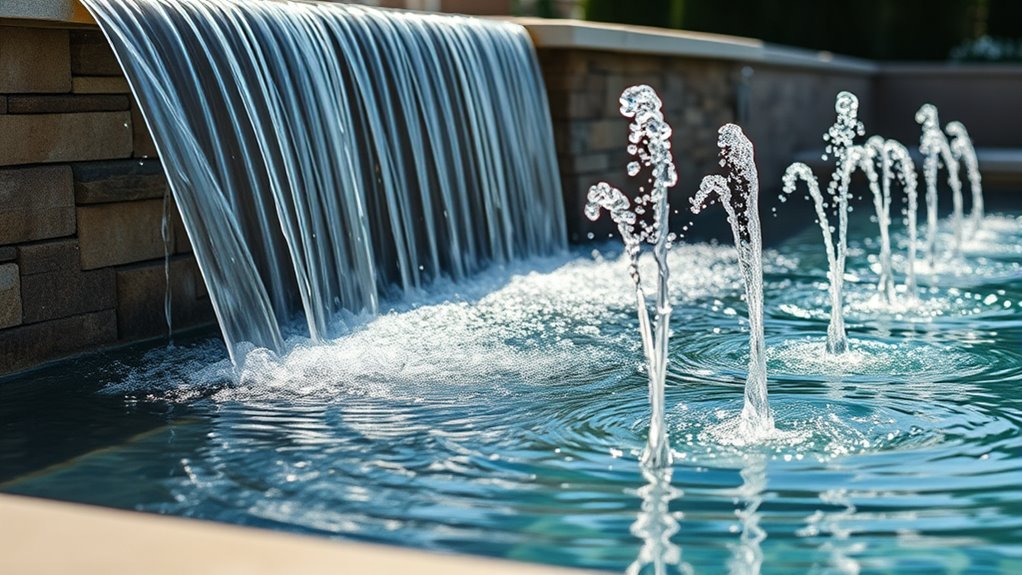
Before installing water features like sheer descents or scuppers, it’s vital to test the water sounds to guarantee they meet your expectations. Doing so helps you avoid surprises after installation and ensures the feature complements your space. Start by setting up a temporary setup or using a similar water source to simulate the final effect. Pay attention to the volume, tone, and flow of the water.
- Use a sound level meter to measure decibel levels and match your preference.
- Experiment with different water flow rates to find the ideal sound intensity.
- Record your tests to compare options and make an informed decision.
Testing thoroughly at this stage saves time and resources, ensuring your water feature creates the perfect ambiance.
Integrating Water Features for Optimal Soundscapes
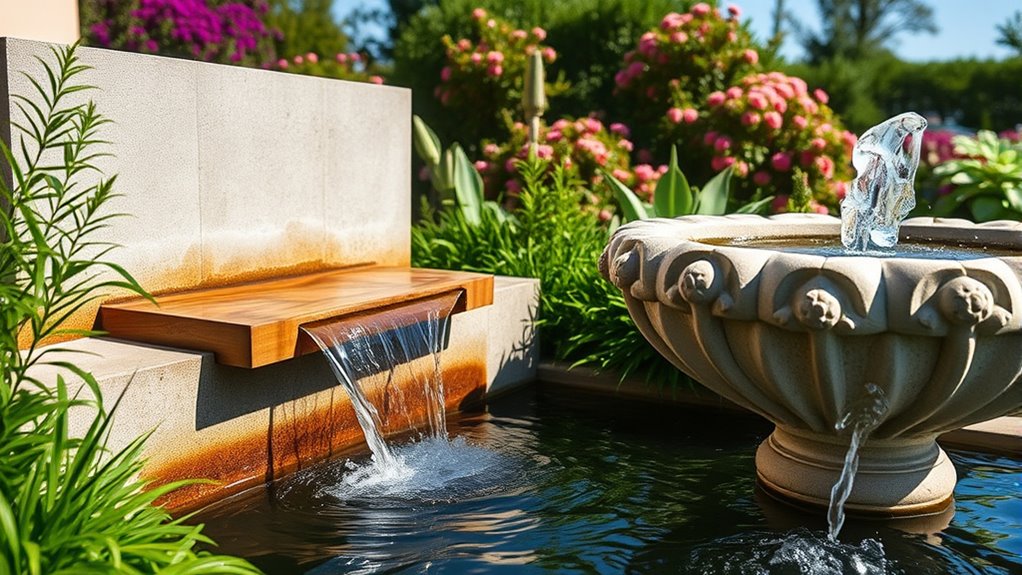
To create the perfect soundscape, you need to consider how to control sound levels, where to place your water features, and how to use plants to enhance the ambiance. Thoughtful placement and strategic adjustments can make a big difference in the overall experience. Integrating these elements assures your water feature complements your landscape beautifully and peacefully.
Sound Level Control
Balancing the sound levels of water features is essential for creating a soothing and harmonious outdoor environment. You want the water to be audible enough to mask noise but not overwhelming or disruptive. To control sound, consider adjusting flow rates, which directly influence volume. Installing adjustable valves allows you to fine-tune the sound easily. Material choices also matter—rougher surfaces like textured metal or stone produce softer, more pleasant sounds compared to smooth, reflective surfaces. Additionally, surrounding landscaping and barriers can help absorb or redirect noise, enhancing overall sound control.
- Use adjustable flow controls for precise volume management
- Choose textured or porous materials for gentler sound production
- Incorporate landscaping elements to modulate noise levels
Placement Strategies
Strategic placement of water features can considerably enhance their soundscape, creating a more tranquil outdoor space. To achieve this, position your water feature where it can be naturally heard without overwhelming the area. Place it near seating zones or gathering spots to maximize its soothing effect. Consider the terrain; placing the feature slightly elevated or on a slope can amplify the sound of flowing water. Avoid placing it directly against walls or hard surfaces that reflect noise excessively. Instead, incorporate natural elements like shrubs or rocks around the feature to diffuse sound and add visual interest. Additionally, think about wind direction, ensuring the sound isn’t muffled or carried away. Proper placement ensures your water feature enriches the environment through sound, fostering relaxation and harmony.
Complementary Plantings
Incorporating plants around your water feature not only enhances its visual appeal but also improves its soundscape by diffusing and softening the flowing water’s noise. Strategic plantings create a natural buffer, reducing harsh sounds and adding gentle, varied textures. Select plants that thrive in moist conditions and complement your water feature’s style. Consider layering different heights for a more immersive experience. Well-chosen greenery can mask unwanted background noise, making the water’s sound more soothing and harmonious. Using plants creatively also attracts birds and beneficial insects, enriching your garden’s ecosystem.
- Use lush grasses to add movement and softening effects
- Incorporate flowering plants for visual interest and scent
- Plant evergreen shrubs for year-round sound absorption
Frequently Asked Questions
How Does the Height of a Water Feature Influence Its Sound?
The height of a water feature greatly influences its sound, as taller features produce louder, more resonant water noises. When you increase the height, the water falls with greater force, creating a deeper, more soothing roar or splash. Conversely, shorter features generate softer, more delicate sounds. So, if you want a more pronounced auditory experience, opt for a taller water feature; for subtle ambiance, choose a shorter one.
Can Water Temperature Affect the Acoustic Qualities of Sheers and Scuppers?
Yes, water temperature can influence the acoustic qualities of sheers and scuppers. As water warms or cools, its viscosity changes, subtly altering the flow and the resulting sound. You might notice a sharper splash when water is colder or a softer hum when it’s warmer. Keep an eye on temperature shifts, because these small changes can unexpectedly transform your water feature’s soothing soundscape.
What Role Does Wind Play in the Sound of Outdoor Water Features?
Wind considerably impacts the sound of outdoor water features by amplifying or muffling the noise. When it blows across the water, it creates ripples and disturbances that can make the sound more dynamic or chaotic. You might notice louder, more turbulent noise on windy days, which can add energy to your space or, if too strong, drown out the gentle flow you prefer. Adjusting the placement of features can help manage wind effects.
How Do Installation Materials Impact the Sound Produced by These Features?
Installation materials shape the sound like a sculptor molds clay. When you choose materials like copper or stainless steel, you’ll notice clearer, sharper sounds, while stone or concrete produce deeper, more mellow tones. Flexible materials like rubber or plastic dampen noise, creating a softer effect. Your choice impacts not just the sound quality but also how the water flows and interacts with the environment, making your water feature uniquely yours.
Are There Specific Water Flow Rates Recommended for Desired Sound Effects?
For ideal sound effects, aim for a flow rate between 2 to 4 gallons per minute for sheer descents and 1 to 3 gallons per minute for scuppers. Adjust based on your desired volume and the size of your feature. Higher flow rates produce louder, more dramatic sounds, while lower rates create gentle, soothing noises. Experiment within these ranges to find the perfect balance that suits your space and preference.
Conclusion
Choosing between sheer descents and scuppers is like selecting the perfect melody for your garden’s symphony. Each brings its unique tune—one whispers softly, the other roars boldly. Trust your ear and environment as your conductor. When you tune into their sounds, you’ll craft a water feature that’s not just seen but felt, transforming your space into a harmonious retreat. Let your choice be the melody that sets the mood for your outdoor masterpiece.


